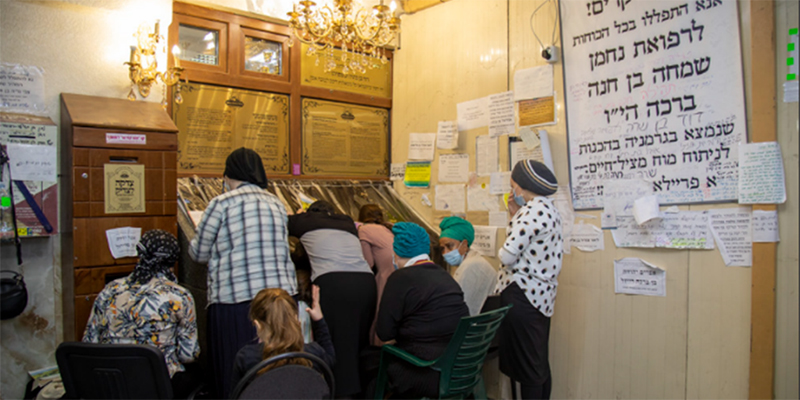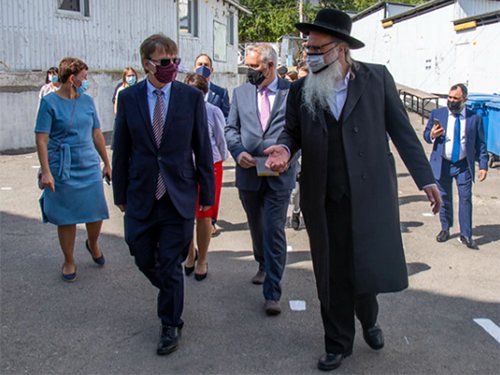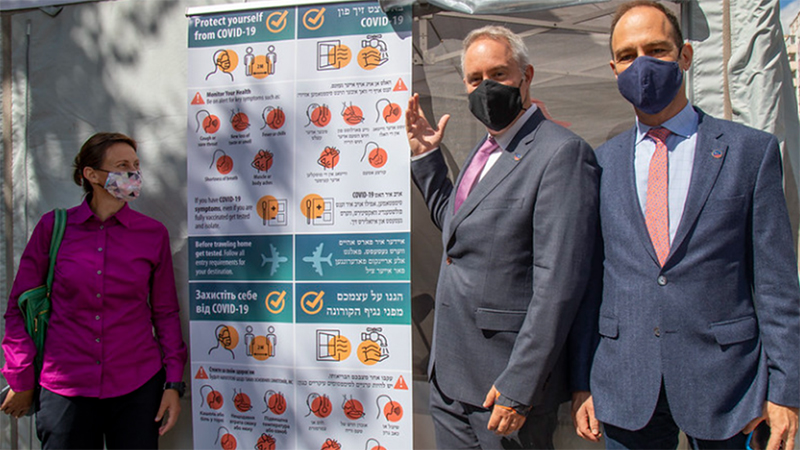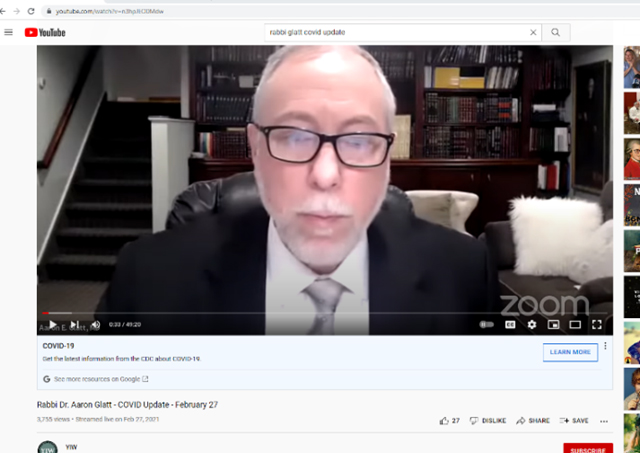Health Officials Prepare for 2021 Religious Pilgrimage to Uman, Ukraine During COVID-19 Pandemic
Summary
- More than 30,000 pilgrims, mainly from United States and Israel, visited Ukraine for the 2021 Jewish New Year celebration during the COVID-19 pandemic.
- The CDC office in Ukraine supported Ukrainian health officials in preparing for a safe event during the pandemic.
- CDC staff based in the United States built relationships with religious leaders in the greater New York area to reach likely travelers to Ukraine and educate them about reducing the risk of COVID-19.
Editor’s note: This story describes public health work done by CDC and partners in Ukraine before the Russian invasion of Ukraine on February 24, 2022.

August 31, 2021: Pilgrims – mainly from the U.S. and Israel – are in Uman, Ukraine, about 120 miles south of the capital Kyiv. They are praying at the burial site of Rabbi Nachman of Breslov – founder of the Breslov Hasidic movement – site of a large Jewish New Year celebration that draws tens of thousands of pilgrims each year. Photo by Svitlana Kravchenko/U.S. Embassy in Ukraine
Since 2020, the Centers for Disease Control and Prevention (CDC) has supported more than 60 countries to respond to the COVID-19 pandemic. One of these countries is Ukraine.
In early 2021, health officials in this eastern European country and the CDC’s office in Ukraine teamed up to plan COVID-19 safety for an annual event that traditionally attracts tens of thousands of Hasidic and Orthodox Jewish visitors, mainly from the United States and Israel.
For more than 200 years, followers of the Breslov branch of Hassidic Judaism travel to a small city in central Ukraine called Uman.
They come to pray at the grave of the founder and spiritual leader of their movement, Rabbi Nachman of Breslov, who died in 1810.
The largest gathering of pilgrims occurs during Rosh Hashanah, the celebration of the Jewish New Year and one of Judaism’s holiest days. It is usually celebrated in September or early October.
The 2020 Uman pilgrimage was cancelled as part of overall COVID-19 travel restrictions imposed by the Ukrainian government. Ukraine lifted the travel restrictions in 2021, allowing international travelers to visit for the September 6 through 8 Rosh Hashanah celebration.
However, health officials were concerned that this large gathering could lead to many new COVID-19 infections.
At least 30,000 visitors were expected to visit Rabbi Nachman’s grave in Uman for the 2021 Rosh Hashanah pilgrimage. Health officials were concerned that having so many people in the area surrounding the gravesite could make proper physical distancing difficult.
By February 2021, the CDC team in Ukraine and staff of the Public Health Center of the Ministry of Health of Ukraine (UPHC) started planning for the arrival of many pilgrims in early September.

Health, diplomatic, and religious leaders tour the neighborhood where many religious visitors gather during the Rosh Hashanah holiday. Seen here from left to right are Olga Gvozdetska, acting deputy director Public Health Center of Ukraine; David Schlaefer, assistance coordinator, U.S. Embassy in Ukraine; Dr. Ezra Barzilay, CDC country director in Ukraine; Rabbi Natan Ben-Nun, president of the Rabbi Nachman of Breslov Charitable Foundation; and in the back on the right is Rabbi Levi Edrei, Federation of Jewish Communities of Ukraine. Photo by Svitlana Kravchenko/U.S. Embassy in Ukraine

CDC Ukraine’s Deputy Director for Programs Nataliya Prodolchak stands on the left side of a large poster with information and illustrations about how to reduce the risk of getting COVID-19. The messages are written in English, Hebrew, Yiddish, and Ukrainian. Dr. Ezra Barzilay, CDC’s country director in Ukraine, and Dr. Christopher Papaharalambus, senior consultant to CDC and the Public Health Center of Ukraine at TEPHINET, stand on the other side of the poster. Photo by Svitlana Kravchenko/U.S. Embassy in Ukraine
“The Ministry of Health and the Office of the President of Ukraine were committed to ensuring that the annual pilgrimage to Uman during the Jewish High Holidays was possible in 2021,”
The CDC provided Coronavirus Aid, Relief, and Economic Security (CARES) Act funds to Ukraine’s Public Health Center. It also provided technical assistance to support UPHC’s preparations to limit the spread of COVID-19 in several critical areas where the tens of thousands of pilgrims, including many Americans, would be gathering.
Collaboration and Building Relationships in United States and Ukraine are Key to Preparing for a Safe Pilgrimage
Ukrainian public health officials worked with religious leaders, the Jewish community, the Red Cross, government officials, and the CDC team to develop a plan to protect the pilgrims.
Since many of the Breslov followers who travel to Uman live in the United States, particularly in the New York area, Dr. Barzilay turned to colleagues from the CDC’s global COVID-19 response team based in Atlanta to participate in this project.
Lauren Erickson-Mamane, MPH joined the Uman project in February as part of the Atlanta-based response team. Her immediate task was to create educational materials to inform and prepare American pilgrims for a safe visit before they left for Uman.
Erickson-Mamane immediately began looking for partners in the religious community to create these key messages.
It Takes a Village to Prepare U.S. Pilgrims for Visit to Ukraine
The Breslov Hasidic community doesn’t have formal leaders to turn to, so Erickson-Mamane and her colleagues reached out to national, state, and local partners in the United States to find other religious leaders to start the conversation.
“We consulted with the White House Office of Faith-Based and Neighborhood Partnerships and the New York Governor’s and New York City Mayor’s Office liaisons to the Orthodox Jewish Community,”
Three rabbis became valuable new partners with the CDC. “Over the next six months, we worked closely to develop a multi-faceted communications strategy for the greater NYC metropolitan area,” Erickson-Mamane explains.
One rabbi she met was Rabbi Dr. Aaron Glatt, who serves as the Chief of Infectious Diseases and Hospital Epidemiologist at a hospital in Long Island, New York.
Since the beginning of the pandemic, Dr. Glatt used Zoom and YouTube to inform thousands in the Orthodox Jewish community about COVID-19 and CDC’s advice.
He is also the Associate Rabbi for a congregation on Long Island, New York, and used the opportunity to address many other congregations to inform them about the latest information on COVID-19.
“The Torah obligates us to take good care of our health, and to protect ourselves as best as possible from potential medical problems,” Rabbi Dr. Glatt explains. “Collaborating with the CDC on making this [Uman] pilgrimage a safe one was of paramount importance.”
Knowing that the CDC was trying to cast a wide net to reach as many Breslov pilgrims as possible, Rabbi Dr. Glatt introduced Erickson-Mamane to the Executive Director of the Rabbinical Alliance of America, Rabbi David Katz. His organization represents more than 950 rabbis and community leaders in the United States.

Screenshot of Rabbi Dr. Aaron Glatt sharing latest COVID-19 information in Zoom meeting on YouTube, February 27, 2021.
Rabbi Katz was impressed by Erickson-Mamane’s resolve to help ensure the safety of pilgrims joining the celebration in Uman.
“Seeing how she took this to heart — to make this pilgrimage as safe as possible for everyone — I said to myself, I will do everything possible to help her,” Rabbi Katz says. “Lauren [Erickson-Mamane] did great work,” he added.
Rabbi Katz connected Erickson-Mamane to other influential Hasidic leaders including Rabbi Zvi Gluck, CEO of Amudim, an organization that helps Jewish community members in crisis.
For the past 13 years, Rabbi Gluck has traveled to Uman, where he works with other philanthropists who provide meals to pilgrims during the holiday.
Over the years, Rabbi Gluck got more involved in American citizen issues, like helping families bring loved ones home who passed away while they were in Ukraine. “I had experience working with the U.S. Embassy and mainly the Ukraine Ministry of Transportation.”
Developing Tools to Prevent COVID-19 Infections Among Pilgrims and Local Residents
The experts at Ukraine’s Ministry of Health, along with the rabbis in New York, religious leaders in Ukraine, and CDC staff at headquarters in Atlanta and in the Ukraine office, worked together and created messages for the pilgrims and local residents in Uman explaining how to prevent getting COVID-19.
“The key message prior to travel was ‘get fully vaccinated’ ’”
CDC staff and partners in the U.S. chose the following ways to reach potential travelers with COVID-19 information:
- Creating a fact sheet in English, Hebrew, Yiddish, and Ukrainian addressing the importance of vaccinations prior to travel and other preventative measures to take during the pilgrimage and upon returning to the United States
- The New York City’s Department of Health and Mental Hygiene paid for full-page inserts of CDC’s fact sheets in five of the major Orthodox publications in the region
- Sending safety tips through WhatsApp message groups
- Highlighting COVID-19 information in English and Yiddish in Orthodox communities

This poster hangs in a large dining hall set up by Rabbi Zvi Gluck’s organization, Amudim. The poster has images of three things to do to lower the risk of getting COVID-19. Below each image, the action is spelled out in Ukrainian, Hebrew, and English: “please wear a mask,” “please use social distancing,” and “please use hand sanitizer.” Photo by Svitlana Kravchenko, US embassy in Ukraine
- Broadcasting prevention messages on Rabbi Dr. Glatt’s weekly YouTube Show
Ukraine’s Public Health Center used the COVID-19 funding provided by CDC to:
- Produce two videos with recommendations for the safe celebration of Rosh Hashanah
- Place 30 poster versions of the CDC fact sheet at airports, in hotel lobbies, local synagogues, and near a holy site
- Distribute 19,000 fact sheets to pilgrims
- Purchase 50,000 COVID-19 rapid antigen tests administered by the Red Cross
- Purchase and distribute 190,000 disposable masks and 19,000 hand sanitizers
- Add Hebrew speaking staff to the national COVID-19 hotline
“This work was made possible by the existing partnership between CDC Ukraine and UPHC,” says Olga Gvozdetska, the acting deputy director of the UPHC, Ukraine’s National Public Health Institute. She adds that “access to financial resources to support activities for this type of events is very important, in order to enable the safe and effective preparation of events of such scale.”
Rabbi Gluck believes that having flyers in English, Yiddish, Hebrew, and Ukrainian, showed pilgrims that COVID-19 had to be taken seriously.
Lessons Learned
“Jewish law requires us to listen to the experts when it comes to medical decision making,” Rabbi Dr. Glatt says. “We certainly fulfilled that mitzvah (commandment) by carefully crafting a religiously and medically sensitive message for all attendees.”
More than 13,000 COVID-19 PCR tests were administered over four days, according to the UPHC. Less than one person for every 100 people tested, had a positive COVID-19 result. About 3,500 rapid COVID-19 tests were also conducted and all came back negative.
While some pilgrims returned to Israel and the United States with COVID-19, most did not.
Over 100 COVID-19 cases were eventually reported among pilgrims. Fortunately, none of the service workers in Uman tested positive two weeks after Rosh Hashanah. Neither did residents in the areas where large groups of pilgrims had gathered.
Building trust and relationships with key Hassidic leaders, both in Ukraine and in the United States, was vital to limiting the spread of COVID-19 during the pilgrimage.
“Working hand-in-hand with the CDC gave comfort to our partners in Ukraine including the Ministry of Health,” Rabbi Gluck says.
Both CDC and the religious leaders praised the collaboration and are looking forward to working together again to tackle future public health emergencies.